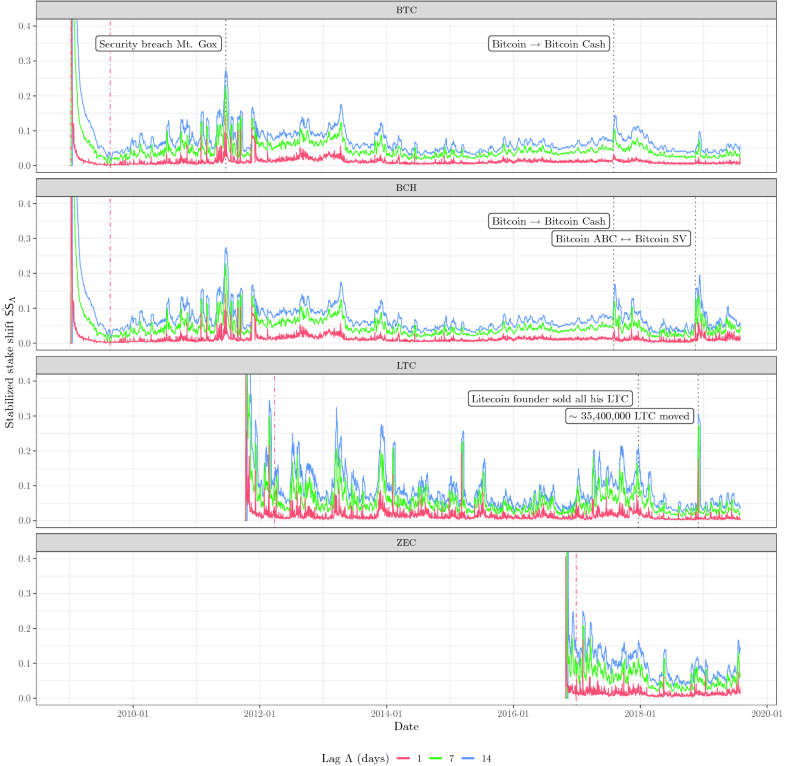Stake Shift in Major Cryptocurrencies: An Empirical Study
- 713 Downloads
Abstract
In the proof-of-stake (PoS) paradigm for maintaining decentralized, permissionless cryptocurrencies, Sybil attacks are prevented by basing the distribution of roles in the protocol execution on the stake distribution recorded in the ledger itself. However, for various reasons this distribution cannot be completely up-to-date, introducing a gap between the present stake distribution, which determines the parties’ current incentives, and the one used by the protocol.
In this paper, we investigate this issue, and empirically quantify its effects. We survey existing provably secure PoS proposals to observe that the above time gap between the two stake distributions, which we call stake distribution lag, amounts to several days for each of these protocols. Based on this, we investigate the ledgers of four major cryptocurrencies (Bitcoin, Bitcoin Cash, Litecoin and Zcash) and compute the average stake shift (the statistical distance of the two distributions) for each value of stake distribution lag between 1 and 14 days, as well as related statistics. We also empirically quantify the sublinear growth of stake shift with the length of the considered lag interval.
Finally, we turn our attention to unusual stake-shift spikes in these currencies: we observe that hard forks trigger major stake shifts and that single real-world actors, mostly exchanges, account for major stake shifts in established cryptocurrency ecosystems.
Keywords
Cryptocurrencies Blockchain Stake shift Proof of stakeNotes
Acknowledgments
We thank Patrick McCorry for reviewing and commenting on the final draft, and our AIT colleagues Hannes Koller and Melitta Dragaschnig for insightful discussions regarding the Apache Spark implementation. Work on this topic is supported inter alia by the European Union’s Horizon 2020 research and innovation programme under grant agreement No. 740558 (TITANIUM) and the Austrian FFG’s KIRAS programme under project VIRTCRIME (No. 860672).
Supplementary material
References
- 1.Nakamoto, S.: Bitcoin: a peer-to-peer electronic cash system (2009)Google Scholar
- 2.Digiconomist: Bitcoin energy consumption index. https://digiconomist.net/bitcoin-energy-consumption. Accessed 15 Sept 2019
- 3.Chen, J., Micali, S.: ALGORAND. arXiv e-prints. arXiv:1607.01341 (2016)
- 4.Kiayias, A., Russell, A., David, B., Oliynykov, R.: Ouroboros: a provably secure proof-of-stake blockchain protocol. In: Katz, J., Shacham, H. (eds.) CRYPTO 2017. LNCS, vol. 10401, pp. 357–388. Springer, Cham (2017). https://doi.org/10.1007/978-3-319-63688-7_12CrossRefGoogle Scholar
- 5.Bentov, I., Pass, R., Shi, E.: Snow white: provably secure proofs of stake. Cryptology ePrint Archive, Report 2016/919 (2016). http://eprint.iacr.org/2016/919
- 6.David, B., Gaži, P., Kiayias, A., Russell, A.: Ouroboros praos: an adaptively-secure, semi-synchronous proof-of-stake blockchain. In: Nielsen, J.B., Rijmen, V. (eds.) EUROCRYPT 2018. LNCS, vol. 10821, pp. 66–98. Springer, Cham (2018). https://doi.org/10.1007/978-3-319-78375-8_3CrossRefGoogle Scholar
- 7.Badertscher, C., Gazi, P., Kiayias, A., Russell, A., Zikas, V.: Ouroboros genesis: composable proof-of-stake blockchains with dynamic availability. In: Lie, D., Mannan, M., Backes, M., Wang, X. (eds.) ACM CCS, pp. 913–930. ACM Press (2018)Google Scholar
- 8.Badertscher, C., Gaži, P., Kiayias, A., Russell, A., Zikas, V.: Ouroboros chronos: permissionless clock synchronization via proof-of-stake. Cryptology ePrint Archieve, Report 2019/838 (2019). https://eprint.iacr.org/2019/838
- 9.Gaži, P., Kiayias, A., Russell, A.: Stake-bleeding attacks on proof-of-stake blockchains. Cryptology ePrint Archive, Report 2018/248 (2018). https://eprint.iacr.org/2018/248
- 10.Gilad, Y., Hemo, R., Micali, S., Vlachos, G., Zeldovich, N.: Algorand: scaling Byzantine agreements for cryptocurrencies. Cryptology ePrint Archive, Report 2017/454 (2017). http://eprint.iacr.org/2017/454
- 11.Chen, J., Gorbunov, S., Micali, S., Vlachos, G.: ALGORAND AGREEMENT: super fast and partition resilient byzantine agreement. Cryptology ePrint Archive, Report 2018/377 (2018). https://eprint.iacr.org/2018/377
- 12.Leung, D., Suhl, A., Gilad, Y., Zeldovich, N.: Vault: fast bootstrapping for cryptocurrencies. Cryptology ePrint Archive, Report 2018/269 (2018). https://eprint.iacr.org/2018/269
- 13.Garay, J.A., Kiayias, A., Leonardos, N.: The Bitcoin backbone protocol: analysis and applications. In: Oswald, E., Fischlin, M. (eds.) EUROCRYPT 2015. LNCS, vol. 9057, pp. 281–310. Springer, Heidelberg (2015). https://doi.org/10.1007/978-3-662-46803-6_10CrossRefGoogle Scholar
- 14.Kappos, G., Yousaf, H., Maller, M., Meiklejohn, S.: An empirical analysis of anonymity in Zcash. In: 27th USENIX Security Symposium (USENIX Security 2018), Baltimore, MD, pp. 463–477. USENIX Association (2018)Google Scholar
- 15.Meiklejohn, S., Pomarole, M., Jordan, G., Levchenko, K., McCoy, D., Voelker, G.M., Savage, S.: A fistful of Bitcoins: characterizing payments among men with no names. In: Proceedings of the 2013 Conference on Internet Measurement Conference, pp. 127–140. ACM (2013)Google Scholar
- 16.Möser, M., Böhme, R.: Join me on a market for anonymity. In: Proceedings of the Workshop on the Economics of Information Security (WEIS). University of California at Berkeley (2016)Google Scholar
- 17.Gaži, P., Kiayias, A., Zindros, D.: Proof-of-stake sidechains. In: 2019 IEEE Symposium on Security and Privacy (SP), Los Alamitos, USA, pp. 677–694. IEEE Computer Society (2019)Google Scholar

